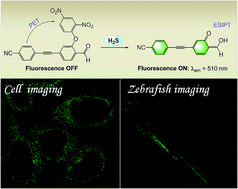A PET and ESIPT based fluorescent probe for the imaging of hydrogen sulfide (H2S) in live cells and zebrafish†
Abstract
H2S is an important signaling molecule in living systems and participates in a series of physiological and pathological processes. In situ and rapid detection of H2S levels in living systems is of great importance to the in-depth study of its physiological and pathological roles. Herein, we present a new fluorescent probe (DFAN) for the detection of H2S in live cells and zebrafish. The probe DFAN utilized the auxiliary action of the ortho-aldehyde group to promote the thiolysis of 2,4-dinitrophenyl ether, and achieved a highly sensitive and selective response to H2S. The response mechanism of the probe DFAN to H2S is an integration of PET and ESIPT mechanisms. Moreover, the probe DFAN was successfully used for the fluorescence imaging of H2S in live cells and zebrafish.

- This article is part of the themed collection: Analytical Methods Recent HOT articles


 Please wait while we load your content...
Please wait while we load your content...